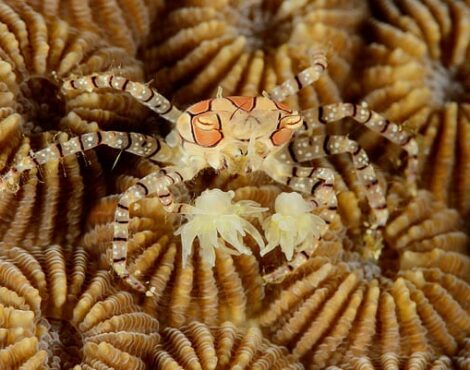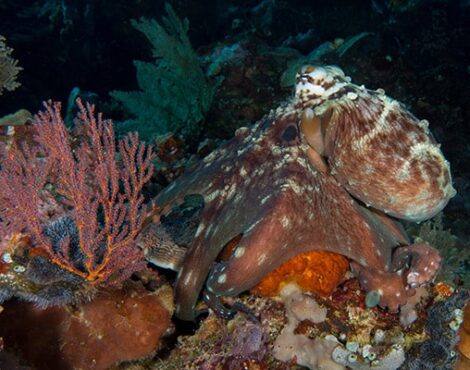Hidden away under rock and rubble is one of the most important, yet misunderstood predators of shallow tropical and subtropical reefs. The order of Stomatopoda, or more commonly known as Mantis Shrimp, are a relatively large group of marine crustaceans with around 400 described species. They are actually a lot more common than most people think, however as they spend most of their lives hidden in their burrows, they are spotted less frequently than other, rarer critters. These fascinating critters have gained somewhat of a reputation over the last few years, as videos of them cracking crab shells like a walnut and smashing aquarium glass have circled the internet.
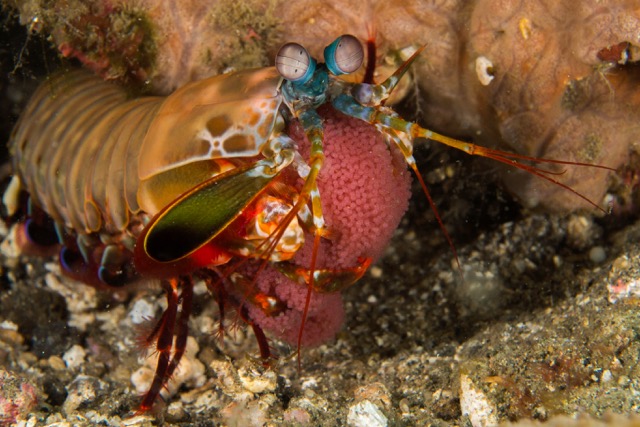
This relatively large crustacean (average size across all species is around 10-15cm, although some species can reach close to 40cm) is typically solitary, spending much of their lives hiding or improving their burrows by creating new passageways and exits. Unlike most other crustaceans, they usually hunt and chase their prey, delivering the fatal blow with their powerful claws. These claws have evolved to become powerful close range weapons, and different species have evolved different styles of claws, but overall there are two distinct types which allows us to separate the species.
Smashing Mantis
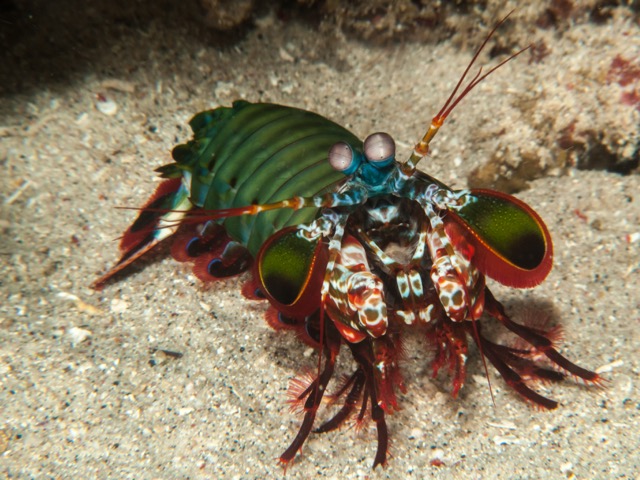
The claw of these mantis are like heavy clubs, which allows them to bludgeon their prey, and easily crack open other species of hard shelled crustaceans and gastropods. This smashing attack is one of the fastest, if not the fastest in the animal kingdom. They can rapidly swing their club-like claw from nothing to 23m/s, or 83km/h. This strike is so fast, that it creates cavitation (vapour filled) bubbles between their claws and their prey. These cavitation bubbles will collapse upon impact, creating a double blow; first by their claw, followed by the collapsing cavitation bubble. Even if the claw misses the target, there is a good chance the shockwave from the collapsed bubble will either shock or kill the prey.
Using this ability, smashing mantis shrimp can have easy access to usually difficult meals, such as crabs, oysters, mussels, and snails.
Spearing Mantis
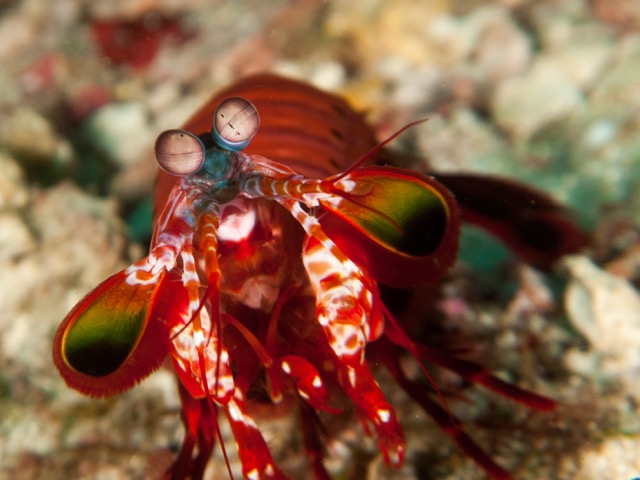
These mantis have spear like, spinney claw topped with barbed tips. Spearing mantis unfold their claws in a similar motion as the smashing mantis, however the claws are much more fragile and are unable to inflict damage in the same way. Instead, spearing mantis shrimp tend to hide in a hole and wait for fish or other soft bodied animals to pass overhead, before stabbing upwards and impaling their prey.
Mantis Shrimp: Fascinating Behaviors and Intelligence
Mantis shrimp are quite long lived, with an average lifespan of 5-7 years, although some individuals have been known to live for over 20 years. Because there are so many different species, it is difficult to pin point any specific behaviours in all areas of their lives, from daily occurrences, to breeding; some species fight over territory, others learn to recognise their neighbours and keep to their own space; some species will mate and then separate, others form monogamous relationships where both the female and male will look after the eggs. One thing that holds true for all species of mantis shrimp, is they are relatively intelligent, being able to learn and recognise others by vison, and possibly even an individualâs scent.
Hidden Gems of Bunaken: Spotting Mantis Shrimp in the Reef
They are found dwelling in shallow tropical and subtropical reefs around the world, and we have our fair share here in Bunaken Marine Park. They are actually very common on the reef tops and sloping walls throughout Bunaken, however they are much harder to spot because there are so many nooks can crannies in the reef. The easier way to spot them is on the North Sulawesi mainland, especially on the dive sites that have a good mixtures of sand, rubble and coral.
Colorful Encounters: Peacock and Pink-Eared Mantis Shrimp of Siladen
As mentioned before, the behaviours between different species varies greatly. The most attractive species that are commonly seen around Siladen are the peacock mantis, with its incredible technicolour shell, or the pink-eared mantis, with, as its name suggests, a beautiful pair of bubble-gum pink âearsâ. These are both smashing mantis, and are more common to spot during the day. The peacock mantis is an especially bold species, often completely leaving its burrow and wandering around the reef.
Nighttime Ambush: Spearing Mantis Shrimp and Their Stealthy Hunting
If you want to spot some spearing mantis, the best thing to do is head out on the dive boats after the sun has set. These ambush predators litter the sand after night fall, simply waiting for unsuspecting fish to pass by. Although many photographers would love to capture the moment one strikes its prey, this is unfortunately, almost impossible. The speed of the attack far surpasses not only our reflexes, but also the speed even the best cameras can work at. A better option might be to video, and know knows, maybe you get lucky and get some good footage, although you will need to slow it down to fully appreciate it. Despite their large(ish) size, donât worry if you have packed your super macro lens. The eye of a mantis shrimp (which deserves a blog all on its own) is one of the most beautiful and intricate visual systems in the animal kingdom, and makes for a superb macro image.


